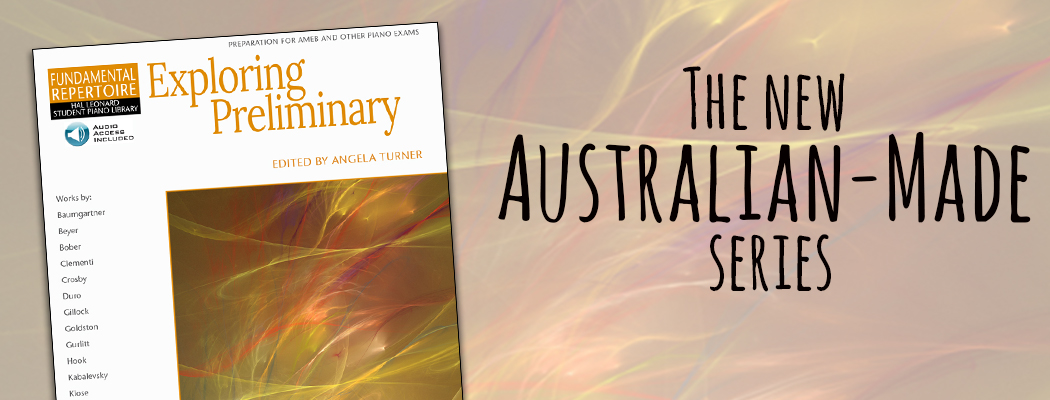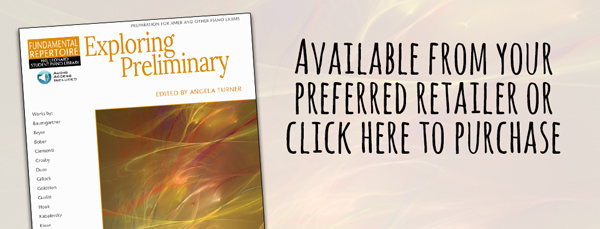In the three years since commencing the research for the new ‘Exploring’ series for Hal Leonard Australia, I’ve had the joy of reviewing thousands of score volumes, and tens of thousands of pieces of solo and duet repertoire, thinking about what might be of interest to Australian teachers and students. In the last year, my focus has been upon preparing ‘Exploring Preliminary’, with approximately 15,000 pieces reviewed and played. There will be many more thousands of pieces to be reviewed by the time the second volume ‘Exploring Grade 1’ is released next year. (It’s safe to say that over the next few years as the later grades are released, I’m seriously going to have to consider more bookshelves!)
“This is a volume that will work with multiple exam syllabi. For example, you could sit either a traditional AMEB exam, or a Piano for Leisure exam with ‘Exploring Preliminary’.”
There have been so many terrific composers and works to choose from, the short list alone for ‘Exploring Preliminary’ could have spanned numerous volumes. To whittle down the selections was challenging, and had it been as simple as picking about 30 of my favourite preliminary pieces, this book would have come out a lot sooner! Many students at this level are coming from a method book environment, where new concepts are carefully introduced, then reinforced through the repertoire and other activities. For this volume, it was therefore a guiding aspiration to find the right combination and sequence of works that would lend its potential to creating scaffolded learning experiences.
Teaching Notes on each piece
For every piece in the book, brief teaching notes are provided, along with possible creative tasks. There are often notes about the technique(s) involved and how they might potentially be conveyed to students. Examples of some creative tasks might include suggestions for transposing pieces to different keys; taking a major piece and making it minor, or vice versa; and some starters for improvisation using ostinatos as featured in a piece. To provide stronger possible links with scale learning, the keys of most pieces match Australian preliminary exam technical syllabi. Scales are often taught with an exam in mind, however their relevance and understanding would potentially be made clearer if learnt in context with pieces. In providing a starting point for creative exploration of the concepts, I hope teachers will feel free to adapt them as befits the needs of their individual students.
Classical, popular and more contemporary solo repertoire
Another of the guiding principles was to provide the options of classical, popular and more contemporary solo repertoire within a single volume, in addition to duets. A typical student of the current generation is exposed to a range of sounds and styles. And duets hold such learning benefits, both musical and social, that it seems terribly sad to enjoy them via method book accompaniments, to simply lose touch as soon as one starts on the graded repertoire track! The selected duets feature parts of about matched difficulty, allowing two students to be able to play together, and to have the option of swapping parts and learning different roles.
Works from multiple Syllabi
Given the range of repertoire, this is a volume that will work with multiple exam syllabi. For example, you could sit either a traditional AMEB exam, or a Piano for Leisure exam with ‘Exploring Preliminary’. There are items that could be used with most of the major exam boards, including the various ANZCA syllabi, ABRSM and Royal Conservatory (Canada/USA).
One of the interesting and rather surprising discoveries in reviewing such a large dataset of repertoire at a single graded level, across all the international major exam boards, was to become acutely aware of the very wide range of skills expected within the preliminary level. With arguably the widest spread of levels within the earlier grades, one of the strong reoccurring themes has been the expectation of touch control and coordination between the hands. Hence, in ‘Exploring Preliminary’, there are numerous pieces that will serve some purpose in developing these vital physical aspects of technique, with varying touches as a focal point.
I chose to introduce pedal in the volume, with about a third of the pieces utilising the sustain pedal; one piece even calls for the soft pedal! This allows for some wonderfully atmospheric pieces, which is an exciting sound world for a preliminary level student! Mostly they are pieces that require long held pedals, as opposed to coordinated/syncopated pedaling. As the volume progresses, pedal changes are still extended, but might occur at the ends of long phrases; there are also a couple of works that would benefit from a more coordinated pedaling technique.
Recordings
It was vital to me to ensure that the volume was well supported by recordings. They are available for free download from the Hal Leonard website, with a unique download code in each book. There are also videos of each solo piece made available on a dedicated YouTube channel. From my own teaching experiences, it’s always useful to have access to videos that aren’t of a 3 or 4-year-old prodigy, that might put off your very capable 8-year-old student! At the very least, these are reliable performance models on an instrument that is in tune!
Over the next months, I will also be uploading discussion videos about each piece. These will elaborate upon some of the exploratory creative tasks and key features, with demonstration and discussion around the concepts. All the videos can be found on YouTube here
Whether you’re working towards exams, or simply progressing through the level, I hope you’ll enjoy exploring the series!
Little Flower Girl of Paris
– William Gillock
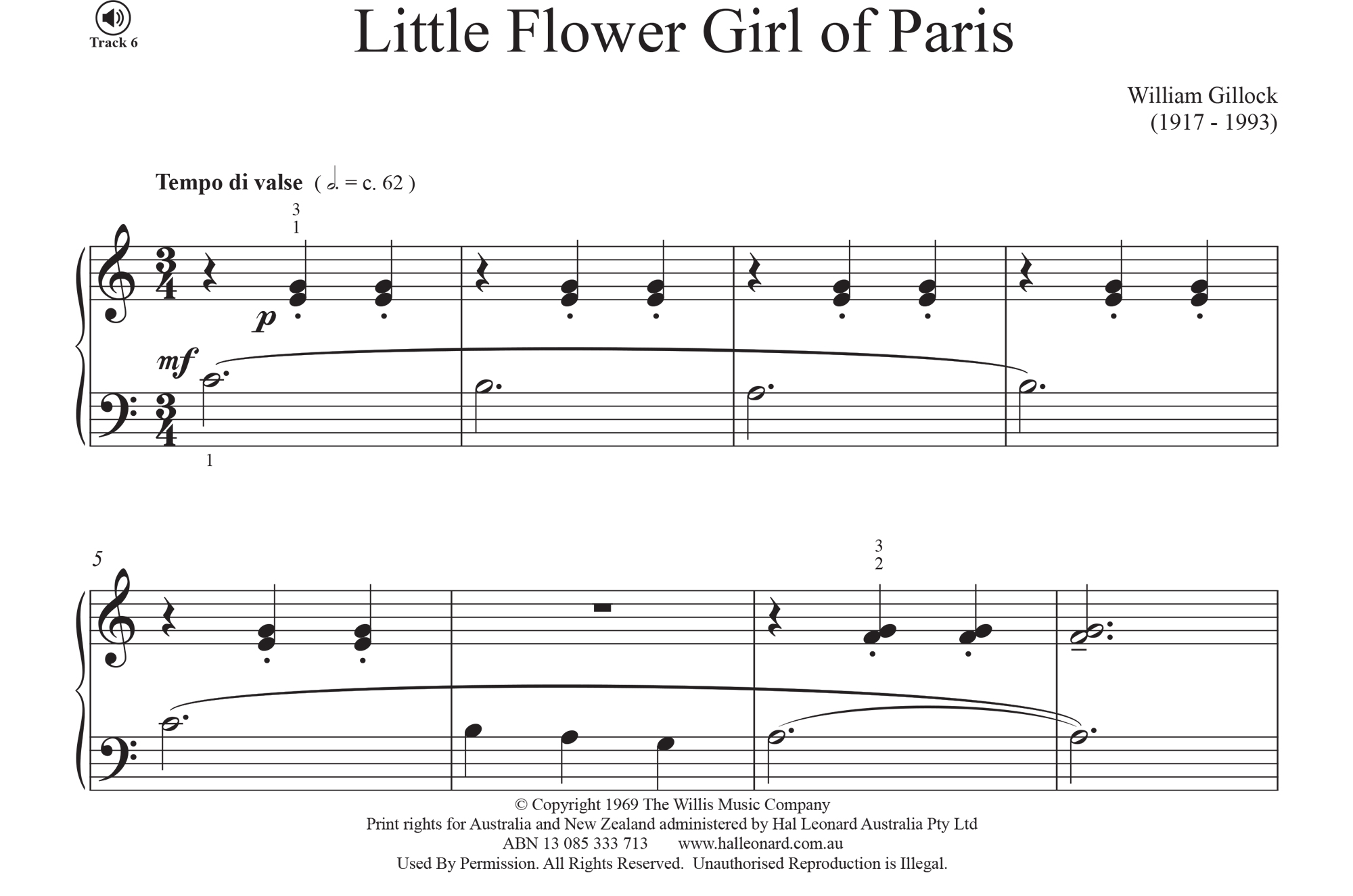
This work represents much of what I admire about Gillock’s writing. Pedagogically, it is very clear, and yet there is artistry in conveying the work’s charm and clear sense of character. The primary focus is the balance between the hands, and control of different touches, with a clear legato line and the left, and a crisp, even staccato in the right. It may take students some mental adjustment to get used to the left-hand melody. In the second half of the piece, the roles are reversed with a right-hand melody. The hands never come down simultaneously in this piece, so it gives students a better chance at learning how to control the differing touches. It can be helpful to concentrate on gross movements first: students can try tapping on the lap, or on the lid, before applying to more specific movements and notes. Discussing the motions as “in – out – out” may help some students. Ghosting or shadowing the accompaniment may later help to refine the balance.
Circle Dance
– Ferdinand Beyer
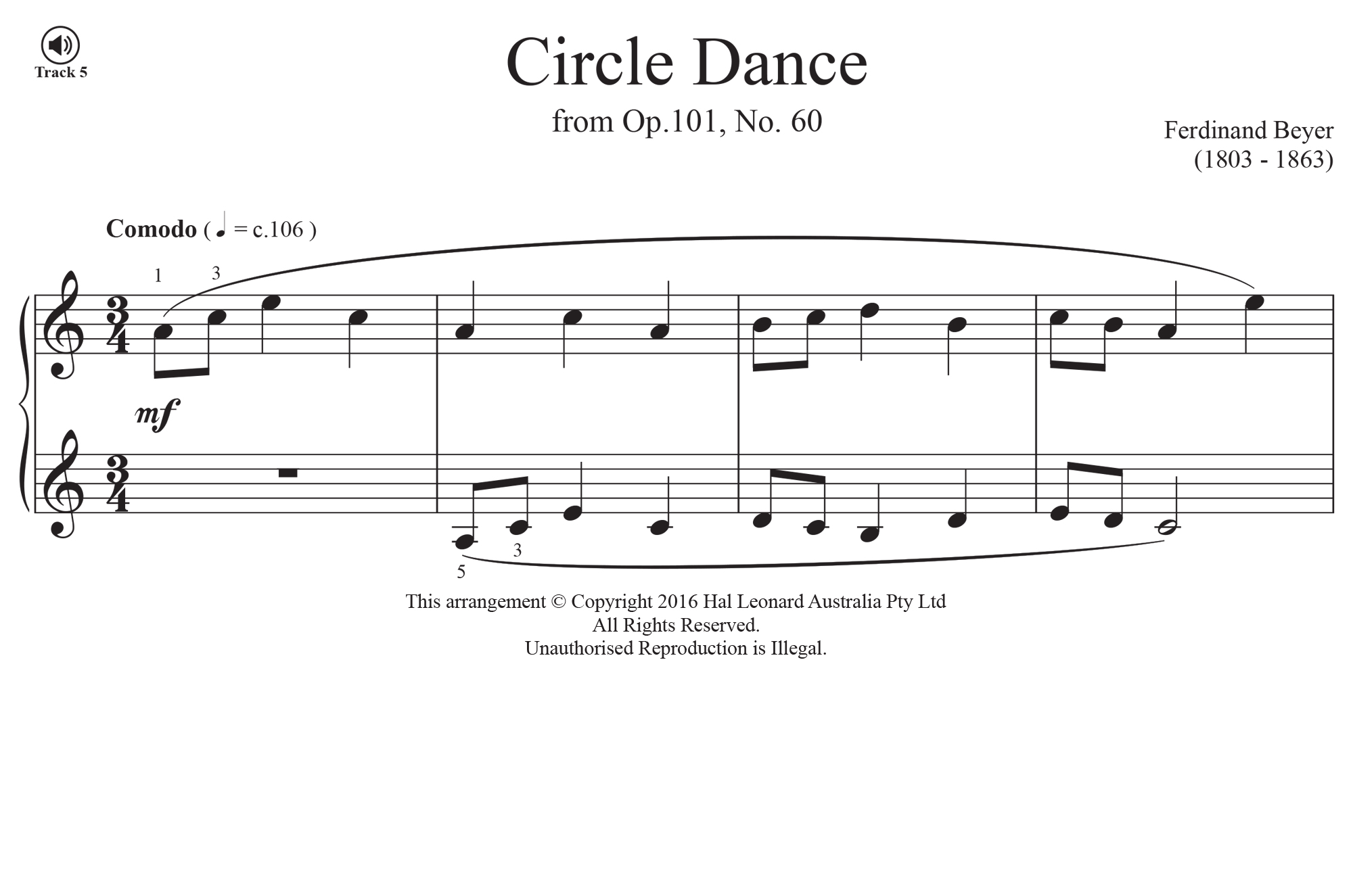
Circle Dance features a discussion between the hands, with a long sense of line. Students should be aiming for a legato, connected touch, without lifting off between the bars. Eventually, conveying the feeling of one beat in a bar with slightly lighter 2nd and 3rd beats, may help in achieving the long phrase. From an analytical perspective, the piece has clear A and B sections, with an A minor/C major relationship. Firstly, what makes it minor sounding, or major sounding? Can you hear the sense of optimism in the sound when it enters the major section? What notes of the scale does it use? Imagine what might it sound like if it were a minor/minor piece? How can you turn the major section into minor? Try playing it. What about a major/major piece? Or even a major/minor piece? How does that change the feeling of the sections?
This piece is also useful as a transposition exercise. After the piece is known, and students are aware that the piece is constructed upon the first five notes of the scale, try applying the A section to E minor. Later, the B section could be transposed to G major. This will be most effective if students are using scales with which they are familiar.
Angelfish Arabesque
– Carol Klose
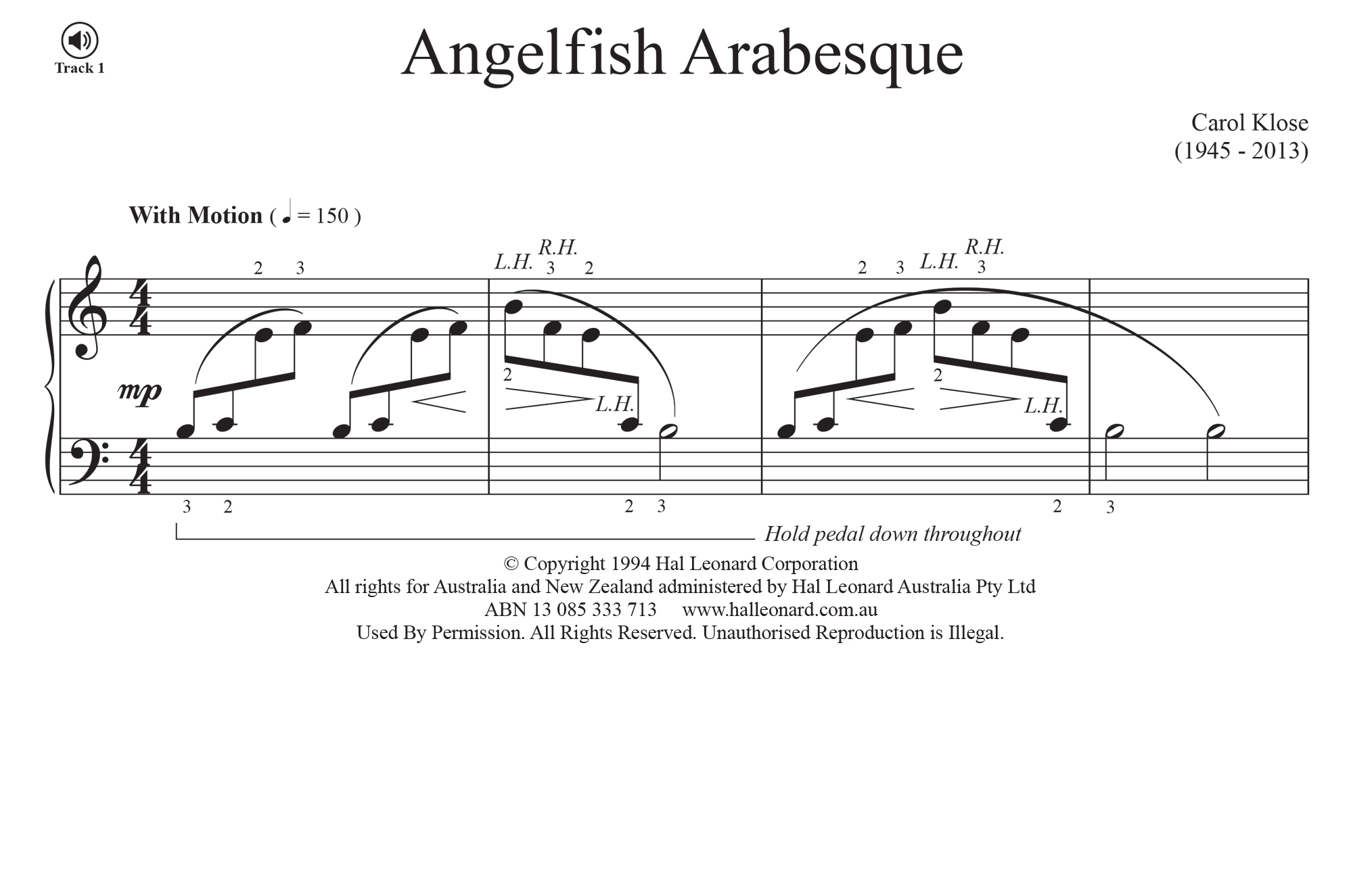
Angelfish Arabesque is very atmospheric, but also an incredibly well-defined and constructed piece. There’s not a single note wasted. The entire piece is built on semitones, and only uses the 2nd and 3rd fingers in each hand. Its primary difficulty revolves around the smooth passing between the hands. Before trying to play the entire piece with flowing connections, my students practice their semi-tone groups as clusters; understanding the feeling of floating between the arms, and preparing the hand crossings. Eventually, pedal is used throughout, but mastering the legato hand crossings without deferring to pedal is advisable first. The piece lends itself well to a range of creative tasks, reinforcing keyboard geography. One possible idea is that students could try using the same semitone note groupings, but improvising the order of the four notes: having freedom within those notes, and trying different registers.
